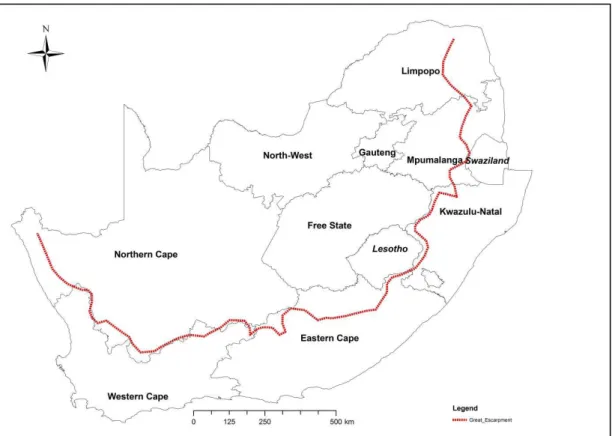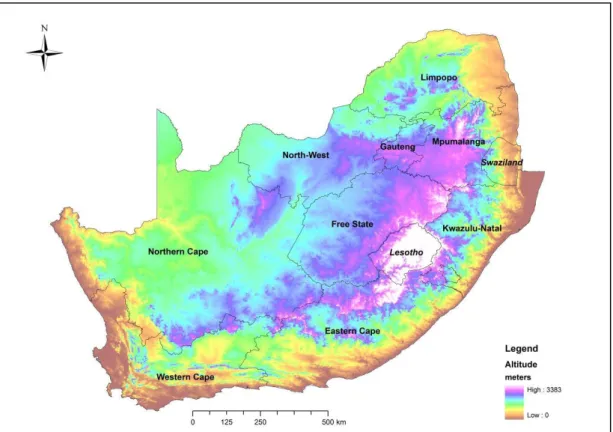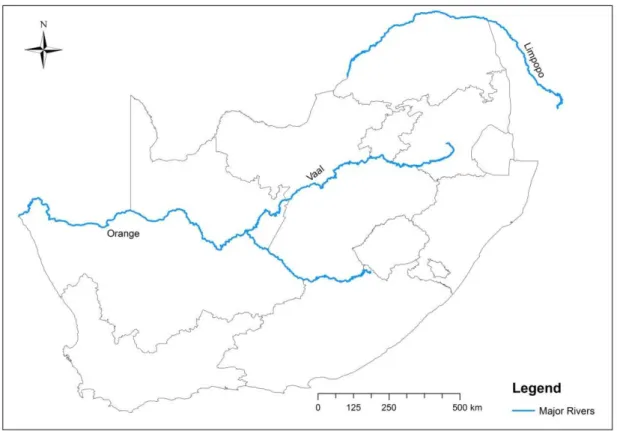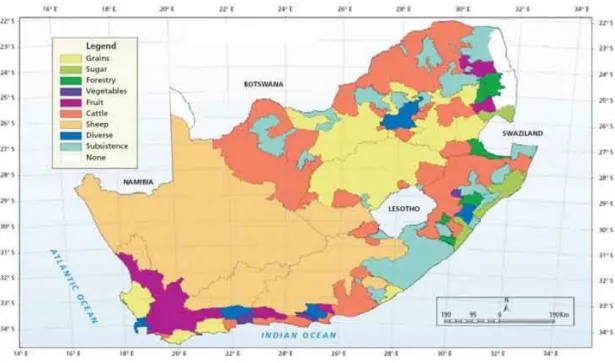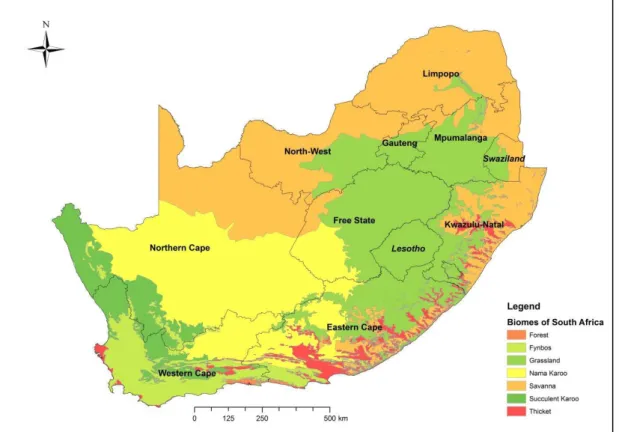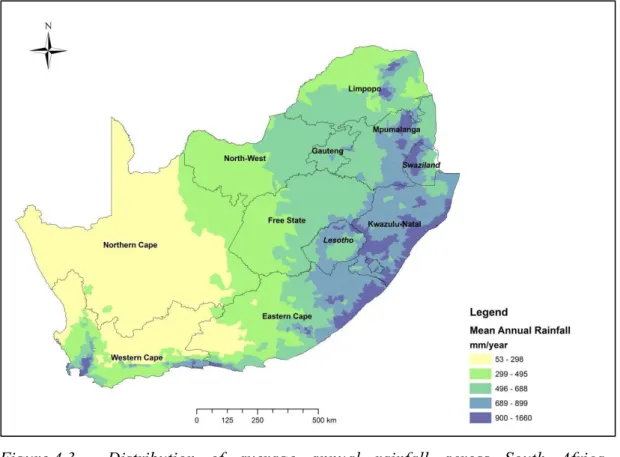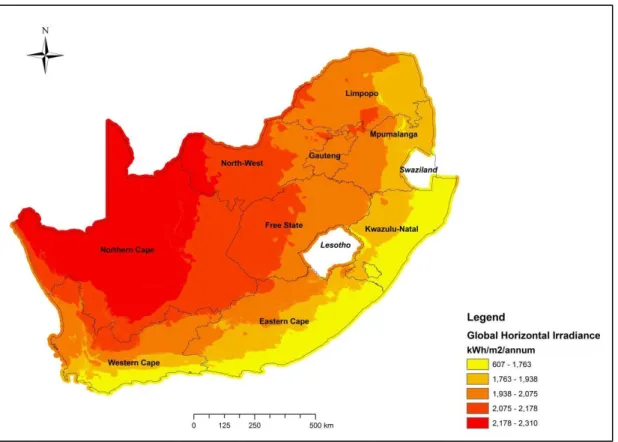Suitability analysis and location theory of algal glycerol biofuel in South Africa using Geographic Information Systems (GIS), International Journal of Geographic Information Science (Submitted 10 December 2013). Global horizontal radiation for South Africa 80 Figure 4.5.a Suitable and unsuitable temperatures for algal growth, where.
List of Tables
Introduction and Background
- Introduction
- Background
- Study Outline
- Study Area
- Introduction
- Geographical Location of South Africa
- Terrain/Relief
- Climate and Seasonality
- Rivers
- Soils of South Africa
- Agro-ecologic Zones and Biomes of South Africa
The Atlantic Ocean borders the western part of South Africa and the Indian Ocean borders it to the east. South Africa has two major rivers: the Limpopo (a stretch of which is shared with Zimbabwe); and the Orange (with its largest tributary, the Vaal) (Figure 2.5.).
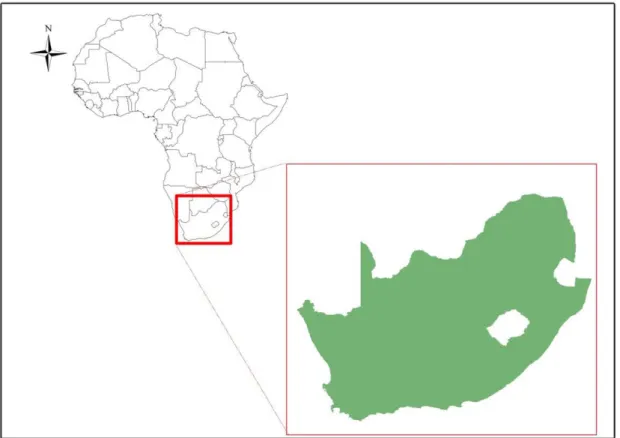
The Application of Sustainable Microalgae Biofuel in South Africa – A Literature Review
Abstract
Introduction
In 1958 at the Mauna Loa observatory in Hawaii, long-term measurements of atmospheric CO2 began (Keeling, 1978). 7 Carbon sequestration in this context refers to the capture of atmospheric CO2 through the process of photosynthesis and its storage in organic reservoirs, either on land or in the oceans; also includes CO2.
Emissions and Climate Change in South Africa
Coal provided 72% of South Africa's total primary energy supply in 2007 and is responsible for 86% of electricity generation (DEA, 2010). South Africa's direct (Scope 115) greenhouse gas emissions are still dominated by a few carbon-intensive companies (CDP, 2010).
Biofuels
Algae are autotrophic (with the ability to photosynthesize), heterotrophic (able to obtain nutrients from external sources) or mixotrophic (able to grow in both ways) (Brennan & Owende, 2010; Mata et al., 2010; Converti et al., 2009). Algal species that prefer salty or brackish water do not use potable freshwater sources (Puppán, 2002; Brennan & Owende, 2010; Mata et al., 2010). Microalgae are theoretically the most efficient photosynthesizers and therefore biofuel producers (Chisti, 2007; Gouveia & Oliveira, 2009; Mata et al., 2010; Brennan & Owende, 2010).
Salinity, pH and turbidity are important factors in the growth and productivity of microalgae (Abril et al., 2004).
Limitations and Knowledge Gaps
Investments in RE projects carry particular risks, including those related to new technologies and the uncertain effective carbon price that traditional energy sources will have to pay. In addition, there are issues of high capital costs, access to finance and the partially public nature of innovation. Page | 48 According to UNEP, the maturity of technologies and related learning effects have increasingly improved their economic competitiveness (UNEP, 2011).
To better understand the necessary growth conditions of specific algal species, the potential co-products and the maximum rate of photosynthesis, further species-specific investigation is needed (Brennan & Owende, 2010).
Summary and Conclusions
Therefore, creating a favorable environment for RE providers has not been an integral part of their business model (Pegels, 2009). Progress has also been made in the development of new products to introduce foreign genes into microalgae (Dunahay, 1993). These efforts are made to improve the production of biofuels from algae and close the economic gap between these technologies and traditional fossil fuels, and much research continues in this area.
The development of large-scale operations is also necessary to determine the actual maximum yields, since most algae yields are theoretical.
Global climate change and ozone layer protection, vulnerability and adaptation: the situation in South Africa. Contribution of Working Group I to the Fourth Assessment Report of the Intergovernmental Panel on Climate Change. Suitability analysis and location theory of algal glycerol biofuel in South Africa using Geographic Information Systems.
Suitability Analysis and Location Theory of Algal Glycerol Biofuel in South Africa using Geographical Information Systems
Introduction
Some algal species do not use fresh drinking water sources, preferring saline or brackish environments (Puppán, 2002; Brennan & Owende, 2010; Mata et al., 2010). Algae can also improve the water quality of polluted streams by removing excess nitrogen and phosphate (Puppán, 2002; Mata et al., 2010; Brennan & Owende, 2010). Research has shown that microalgae have the highest theoretical rate of photosynthesis and thus the ability to produce biofuel (Chisti, 2007; Gouveia & Oliveira, 2009; Mata et al., 2010; Brennan & Owende, 2010).
Given the correct climate, microalgae can be cultivated on an industrial scale throughout the year, continuously producing biofuel (Grobbelaar, 1982; Chisti, 2007; Brennan & Owende, 2010; Mata et al., 2010).
Consultation
36% of Eskom and 50% of non-Eskom consultants do not currently use renewable technologies but are aware of plans to include them in the future energy mix. 91% of Eskom consultants and 100% of non-Eskom consultants are aware of the company's policies to promote energy and water conservation and reduce greenhouse gas emissions. 55% of Eskom consultants and 100% of non-Eskom consultants were able to report their CO2 emissions.
45% of Eskom consultants and 33% of non-Eskom consultants know that their companies are or will consider CCS technology.
Location Theory
29% of the 17 respondents who returned the questionnaire use some form of renewable energy at their location. Further research shows that a large proportion of power stations are located in and around Gauteng and Mpumalanga. Transporting electricity is cheaper than transporting the large amounts of coal needed to produce it.
25 Some of the consultants were not included in this stage, as they did not emit CO2 either.
Needs and Suitability Analysis
The levels of the dams can be easily controlled in times of heavy rain to prevent flooding. For the thinning of air to have a significant impact on the productivity of the photosynthesizing microalgae, the altitude above sea level would have to be much higher than where industrial plants are located in South Africa. This can contribute to the positive life cycle analysis of the site, as little potable water is required.
Many of the proposed limiting factors would not actually be significant or limiting for South Africa (Table 4.3).
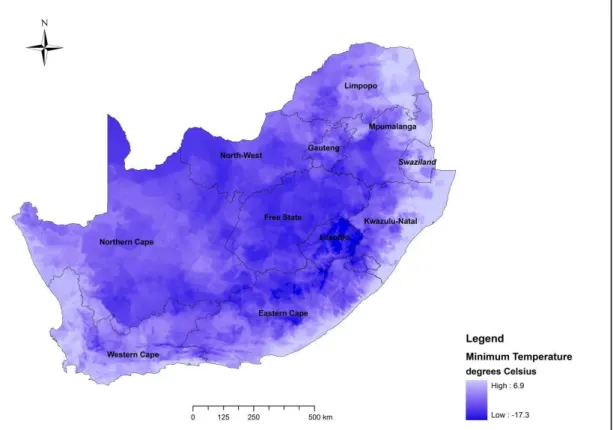
Results
The driest areas of the country are the Northern Cape and northern Western Cape. A large number of consulted study sites are in areas with suitable environmental conditions for algae growth. Two of the remaining three countries are also paper producers, in Kwa-Zulu Natal and Mpumalanga.
Non-Eskom a: This site is located in a bend of the Umkomaas River, on a large industrial footprint.
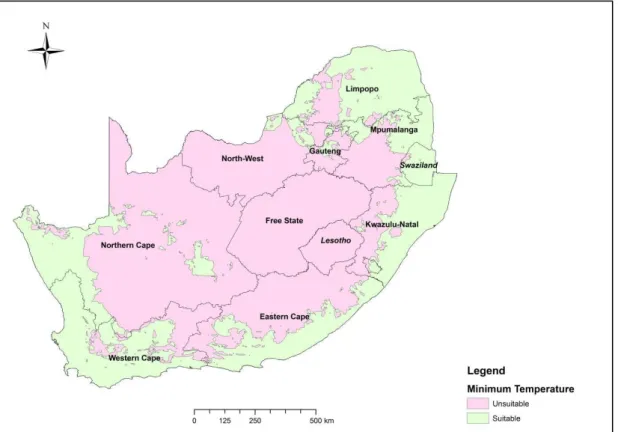
Limitations
However, it was decided to stick to the 1 km buffer in the analysis, as a larger buffer than this would introduce locations outside the desired parameters. For this study, it was decided to include some of the Eskom power plants that have been decommissioned in recent years. As such, it was not possible to use this layer of GIS data to help select ideal sites in South Africa.
The decision to include this area was made as much of the land was found to be suitable for this renewable technology and it is hoped that this information will lead to further research specific to Swaziland.
Discussion
Page | 96 For reasons of privacy, it was decided not to publish the details of those consulted, only the type of industry to which they belong. Of the last five sites that were not excluded due to the environmental restrictions, three of these were from the paper industry. The environmental conditions that will encourage the growth of the trees used in the paper industry are likely to be within similar parameters to those required for algae ponds.
Unfortunately, they did not want to be involved further in the progress of the project.
Conclusion
Of the four non-Eskom sites and one Eskom site remaining at the end of the study (Figure 4.11), it was found that three of the non-Eskom sites were linked to a consultee who had responded to the early consultation, and had returned the completed questionnaire. Glycerol and ß-carotene metabolism in the halotolerant alga Dunaliella, a model system for biosolar energy conversion, glycerol production by Dunaliella. Allowable CO2 concentrations under the United Nations Framework Convention on Climate Change as a function of the climate sensitivity probability distribution function.
Photosynthesis and pigments affected by light intensity and salinity in the halophilic Dunaliella salina (chlorophyta).
Limitations, Discussion and Conclusions
Limitations
Benefits such as social and economic benefits to those living locally in the vicinity of the project areas should be well researched. All modern biofuels undergo a full life cycle analysis: a thorough investigation of the carbon footprint of the production and combustion of the fuel, including all infrastructure, over the life of the industry. A weighted analysis of criteria affecting microalgal growth rates would help create score maps that more accurately weight criteria according to importance.
This meant that such a weighting had to be decided on the basis of the results of the research in this thesis.
Discussion and Conclusions
Apart from the Northern Cape and the Free State, locally produced algal glycerol biofuel could be produced and distributed locally for a large part of South Africa; it will also reduce the environmental and financial costs associated with long-distance transport. South Africa has the ability to take advantage of its suitability for the development of algae biofuel. In Chapter 3 we learn that binding targets have been set for renewable energy sources to be added to the forms of energy supply, and how opportunities are now emerging for foreign energy investment in energy in South Africa.
As the environmental and health costs associated with the use of South Africa's cheap coal reserves continue to rise, and as national and international pressure to use renewable alternatives increases and the cost-competitiveness of these technologies continues to improve, South Africa must consider taking advantage of this opportunity.
Appendices
Consultee Responses to Consultation
Page | 111 Response from Consultant 21 non-Eskom: “We appreciate the trust in which you have written to us. Requests to participate in surveys or to confirm the accuracy of data used in surveys or to provide. For these reasons it is our company's practice not to participate in research, questionnaires, surveys and other similar projects.
We trust that you understand our position and wish you success with your current project.”.
Questionnaire Responses
At Pumped storage stations, instead of the water being discharged, it is retained in the system and reused. Coal is expected to remain part of South Africa's energy mix for the foreseeable future. Scenarios produced by the Department of Climate Change and Sustainability indicated a potential role for CCS in the electricity generation mix, which is expected to be commercially available from around.
Annual CO2 emissions from fossil fuels for [8] are reported in the CDP - link to where this report is available.
